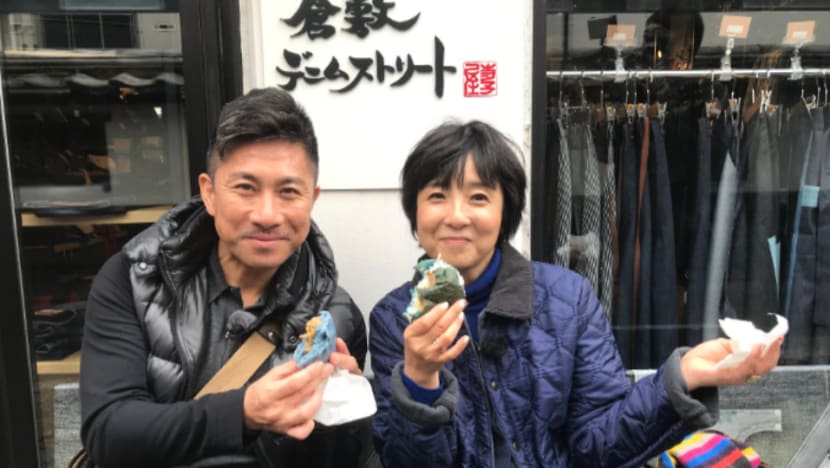Road Trip on from Kagawa to Hiroshima Prefecture (Part 1)
Denim is this week’s buzzword, featuring a "jeans capital", a "denim burger" with a blue bun made of "jeans powder", a jeans-coloured soft serve ice cream and a hotel which uses denim bedding.

Join us for a three-day trip from Kagawa Prefecture to Hiroshima Prefecture across the Setouchi region. This time, we will travel on three local lines - JR Seto-Ohashi Line, JR Sanyo Main Line and JR Kure Line. We will start in Kagawa, cross the Great Seto Bridge, pass Okayama Prefecture and head to Hiroshima Prefecture. Our entire journey will span 233.1km and cover 63 stations.
Our trip begins at Seto-Ohashi Line’s Takamatsu Station in Kagawa Prefecture, the gateway to the islands of the Seto Inland Sea. The railway line also serves as a link between Shikoku and Honshu. We hop on a train called Marine Liner 22 at 10.10am and head to Kojima Station.
We reach Kojima Station after a 30-minute ride. The first thing we notice is that the signboard is made of denim and so are the vending machines. We also see a “jeans” bus. A local tells us about the Kojima Jeans Street, which was established in 2009. Kojima is known as a jeans capital where there are several local jeans shops. One store even sells a jeans-coloured soft serve ice cream. A resident tells us there is a hamburger place which blends “jeans powder” and other ingredients to make the buns, but it is located in the Kurashiki Bikan historical quarter, where there is a Denim Street.
We search for Rivets, which sells the “jeans” soft serve ice cream called Indigo Soft. It is coloured with the natural material indigo, which is used to dye jeans. The ice cream is sweet and salty. We then ask about another recommended spot and are told about Momotaro jeans, which is the leading jeans company in Kurashiki. Its jeans have a 10-year warranty and come in various cuts and models. The jeans can also be custom painted.
Our next stop is Bitchu-Mishima Station. We catch the 11.55am train from Kojima Station and reach Bitchu-Mishima at 12.15pm. We visit a temple near the station and notice some beautiful flowers planted here. We find out about an elderly parishioner who grows these flowers in her field and arranges them in the temple. So we go to Ms Uedera’s field on the other side of the station. The field can be seen from the train windows of the Seto-Ohashi Line. Various types of flowers are grown here throughout the year.
Later, we take the train and head towards Kurashiki, a famous tourist city. After a 15-minute ride, we alight at Okayama Station and switch to the Sanyo Main Line. One of the oldest train lines in Japan, it was first established in 1888. The train pulls into Kurashiki Station at 1.55pm. We plan to spend two hours in this area. We go to Sano-ya, a store which has been around for more than 100 years. The 88-year-old owner tells us that the Kurashiki Bikan historical quarter is a popular tourist spot in Kurashiki City. She also suggests we buy Kurashiki’s well known Murasuzume - a crepe-like pastry made with bean paste - as souvenirs from Kikkodo, which is across her shop.
Kikkodo opened for business in 1877 and Murasuzume is its most popular product. We get to experience making this delicious sweet treat ourselves in a hands-on demonstration, after which we try the freshly made Murasuzume.
We then ask about the burger shop that mixes a denim ingredient in its buns. It can be found at the Kurashiki Denim Street. We walk along a river and enjoy the view of the Bikan historical quarter, before arriving at the place where denim products and other things such as denim soda are sold. We order the 350 yen denim burger and learn that what makes the buns blue are gardenia seeds, which are often used in Chinese medicine. Between the denim-coloured buns, there is a thick meat patty and lots of cabbage.
After this, we take the 3.55pm train to Fukuyama. The train leaves Okayama Prefecture, enters Hiroshima Prefecture and arrives at Fukuyama at 4.40pm. We start asking around for accommodation for the night. A local suggests Oofu-tei in Tomonoura. However, it is full for the night so we ask the hotel to recommend another inn. The staff suggests Kokumin-shukusha but we need to take a bus to the harbour and then a boat to the place.
A resident tells us to try our luck at Anchor Hotel near Fukuyama Station. It has bedding made with Fukuyama denim. We manage to book our rooms. However, the hotel is part of the same chain as Fukuyama Oriental Hotel so we have to check in at the latter instead. Anchor Hotel Fukuyama was previously a condominium but it was subsequently converted to a hotel. On the first floor, there is a bar where guests have breakfast and it is open to everyone, not just hotel guests. Guests who stay at Anchor Hotel also get access to the public baths at Oriental Hotel.
A shop in the nearby city of Ibara created the fabric and clothing amenities - which are dyed with indigo - used in the hotel. An example is the hotel’s haori, a dress which can be worn over Western or Japanese clothes. Guests can wear them when going to the public bath or the bar, and can even sleep in them. Clothing amenities made from the local speciality denim are also sold at the hotel and make great souvenirs. For instance, a bathrobe and sash set costs 10,000 yen, the haori is 15,000 yen, while a denim bag can be bought for 9,000 yen.
Tips:
1) Murasuzume is a must-try sweet treat of Kurashiki
2) Items made from local denim are sold at Anchor Hotel Fukuyama and make great souvenirs
Featured Places - Ep51:












